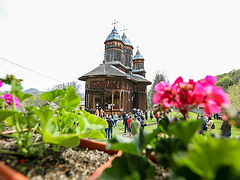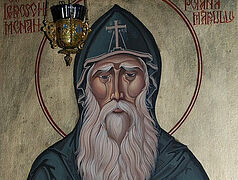 Brother Ioan and Nun Serafima, who came from Russia. 2012
Brother Ioan and Nun Serafima, who came from Russia. 2012
Hermits and hermitesses
I always think how fortunate this gentle man is to see these glorious anchorites of the angelic life! What a great treasure he must have acquired from them! Even worthy monastic monks say to him with genuine admiration:
“You have been given much, Brother Ioan, but you will receive even more in eternity for such blessing!”
And he just laughs in response. Now at sixty-five he has a perfect health and is as physically strong as three men of his age; and he has nothing to lose. He can carry bags of breadcrumbs around the mountains for many years and doesn’t at all consider it work. What will happen when he can’t do it anymore? Well, it won’t be the end of the world and there will be someone instead of him. He doesn’t do anything special—he just carries things.
It’s amazing how naturally he talks about his neighbors in the mountains, as if they had come out of a Patericon. They live right here, two steps away from him, and struggle in the open air, in the cold, in accordance with all the ancient strict rules of ascetic life. Looking at Ioan in his little house in the mountains, you are carried back to the early days of the Egyptian deserts. Indeed, these two nearby mountains, which he knows like the back of his hand, are a living Patericon today.
He showed me through the window of the little house, through a blizzard, some dots in the mountains, the directions by which he walked to hermits:
“There are two monks there, and there are three more hesychasts by the Red Stone, at the Lady’s Stones, in Slatioara, in the old forests. Calinic, Zosima’s disciple, struggles close to the Bison Stone, and an eighty-six-year-old monk still lives there, underground, wrapped in a sheepskin coat, without fire, without bare necessities. He is very thin: skin and bone and spirit. What does he do there? He prays. These people feed on prayer—their feelings are atrophied, and they somehow manage to pass beyond this realm, where they no longer need water and food.
“This hermit did not even allow me to look at his underground cell, where he sleeps and prays. He is known in monasteries, but few have spoken to him and few know his name. They say that some are even unable to see him, and that such schemamonks have the ability to come and pray in mountain monasteries, and no one sees them there. They walk among people and the monastery brethren, but they don’t notice them. They stand at the Liturgy in church by the wall in the shade, and no one sees that they are there.
“Yes, there are still such schemamonks today, who pray like a flame of fire, who never come down from the mountain but die there, and you don’t even know that they are dead. They are eternal.
“And there are even more nuns than monks. They are martyrs! I know five of them in the Rarau Mountains alone, at a great distance from one another. Women live their lives richly adorned with virtues. You can’t talk to them except on Wednesdays, for half an hour.
“There are many more of them in the Giumalau Mountains. These are hermitesses and recluses who retired there from large convents, such as Dragomirna, Neamt, Agapia, Vladimiresti-Galati, from Piatra Fantanele in Nasaud, and even the abbess of Pasarea Convent from Bucharest. And many, many others... Dozens and dozens of nuns; I know twenty-eight anchoresses well. Now, in December, I went there to an old nun to help her. It’s about nine miles from here—it takes me about an hour to get there. I learned from her that some new woman hesychasts had come…”
Right in the middle of our conversation the great spiritual father Iustin (Parvu) from Petru Voda Monastery, his old friend, called him on a crackly phone. He said he would send him two nuns from Poiana Maicilor Convent, which is somewhere under Mount Ceahlau. One of them graduated from Medical School, the other from the Theology School—women who decided to become anchoresses here in the Rarau Mountains. From the day after tomorrow, Brother Ioan would give them shelter in his little house and start making dugouts for them.
 Poiana Maicilor Skete. Photo: Doxologia.ro
Poiana Maicilor Skete. Photo: Doxologia.ro
An ascent to Paradise
I am gradually beginning to understand that it’s no coincidence that these anchorites who lead holy lives choose Ioan. First of all because he knows the mountains well. Besides, he lives there, among them, permanently. They have been watching him from their forest darkness for so many years, seeing his deeds, impeccable behavior and the joy with which he hurries to help everyone—saints and sinners alike. For fifteen years he has been struggling steadfastly in the “desert” without ceasing his obedient Christian life for a minute.
Once he lived in Jasi, spending more than half of his life in an apartment building—a time that he regards as his cross, which he had to bear. When in 1998 he wanted to renounce the world, his family gave their consent, but no one even believed that he would cope there alone.
“Do you really think that being a hermit is for everyone?” his wife, sons and friends told him.
He got off the train at the Pojorata village station and looked at the peaks—he was to climb up the mountain for seven hours to the site where he had decided to make himself a dugout. He was heading towards the peaks when a terrible storm hit him, with hail, rain and winds scratching his face, with fir trees uprooted and falling around him. Several times he said to himself, “I won’t be able to walk up! Had I better go back to the station and travel back to Jasi?” He had this temptation several times. But he didn’t go back.
 Mountains in the vicinity of Pojorata village
Mountains in the vicinity of Pojorata village
He lived three years in a monastery and five years in a dugout on Mount Giumalau. He didn’t particularly like the bustle of monastery life. But the years spent in the chilly solitude of his dugout in the mountains became, without any doubt, the happiest in his life, even the most sublime and divine ones! For 380 days he toiled, without straightening his back, on this cell, cutting it out of rock. Three-quarters deep into the ground, masked with a roof on which he piled earth and moss so that it would not be noticeable from whichever side you approach.
Inside he hung a piece of cardboard with his monastic rule and the ascetic rules of Sts. Basil the Great and Anthony the Great on a nail on the wall. He began to live in purity and simplicity, as he had always wanted to.
In his first winter, even if he had wanted to return, he wouldn’t have been able to. He badly dislocated his leg in the forest, it was very swollen, and he could not walk. He stayed there alone for three months under snow. For the last two weeks he didn’t even have anything to eat, so he began to dig the ground, gnawing the roots of trees. Closer to spring, when monks from Pojorata saw him limping towards the monastery, they were staggered:
“How have you survived, good man?”
He was walking, shining with his smile, waiting for some food to be given to him and he would climb back up.
He said that in the following winters he felt neither need nor loneliness. He stayed in his dugout as if in another, Heavenly realm, the existence of which he had only suspected; but it had never been so accessible.
“I was above this world. I saw sights that enchant you with their beauty. I forgot about hunger and cold. These mountains are pure, perfect beauty. I knew all the animals that had become my neighbors: I looked through the window (covered with dust) of my dugout and saw roe deer, wild boars, wolves, a bear passed right next to my hut and a deer followed it. I was not afraid of anything: animals were my friends. And I was able to pray to God... with joy! Without any effort, without difficulty. I could embrace all the mountains! It was joy, which I had not experienced even as a child.”
A nameless nun
He learned true prayer from a woman—an anchoress who lived invisibly in the forests of Giumalau and was reputed to be “absolutely exceptional” by the surrounding monasteries. One day the abbot of Pojorata Monastery sent for Ioan to come down to them from his mountain.
“Brother Ioan, you know these mountains better than we monks do. We really need one nun—we want to see her so that she can tell us some words for the benefit of our souls, because times are very tough for monasteries now. She is nameless. Could you possibly go and look for her and tell her we’re calling her here?”
 Bistrița River Valley in the Giumalau Mountains
Bistrița River Valley in the Giumalau Mountains
What could Ioan say? He said yes and did not object.
It was late autumn, the middle of the Nativity Fast. At the way out of the monastery, the father-confessor came up to him and said:
“If it is not the will of God, you won’t find this nun. Even if she’s very close to you, you may not see her anyway. And you should go and look for her while fasting and praying hard. May God bless you, for these hesychasts of unearthly life do not reveal themselves to everyone.”
He set off the same day. He thought he would find her quickly—in a few days at the most. Judging by his past journeys and the stories of other hesychasts whom he knew, he imagined in which part of the mountain she could dwell. He went on the same day… and searched for her for four years day in and day out, walking from one end of Giumalau to the other, peak after peak, hollow after hollow, cave after cave.
“It was my huge penance. I tore I don’t know how many pairs of shoes to shreds, but I kept walking despite rains, blizzards, fatigue and hunger… Through ravines, thickets and steep cliffs. I told myself that I was unworthy of it, that God ordained that I wouldn’t find her. But still, there were days when it seemed that I almost saw her—I sensed that she must be here, somewhere very close, that I should see her very soon.
“I don’t know how to explain it properly. It was as if I knew she was two steps away from me, but she always slipped away from me. Maybe she saw me all the time, all those years, too, but she didn’t want to appear to me. I don’t know. Maybe she was watching me, testing me to see if I could stand it, how much patience I had to walk around the mountains like crazy.
“Each time I returned to my dugout more tired and more depressed. At some point I was overcome by despondency. Despondency is a serious temptation. It was in early winter. It drizzled for three weeks and the fog was thick, the air was damp, so nothing could be seen two steps away. I was seized with such melancholy that I didn’t even know what to do, felt extremely uneasy and was going crazy. I circled around my dugout, finding excuses to do something—go and fetch firewood or cook food, but it didn’t seem to make sense.
“One evening, when I was standing outside in front of my dugout feeling utterly dejected, I suddenly heard a rustling in the bushes and saw a shadow moving there. I thought it was a bear or some other wild animal: who else could be on top of a mountain in such a fog and drizzling rain? I took a pick hammer. Then I saw the shadow stop at a fir tree. I looked closer: it was a woman, a nun! I made the sign of the cross. How could she get here? She was looking at me, and I was looking at her holding the pick hammer in my hands. I froze. After standing for a while, the nun came up to me and said:
“May God speed you.”
I asked her:
“Are you the nameless nun?”
She answered in a barely audible voice:
“No, I’m an ordinary poor nun who got lost here.”
But I knew everything in these mountains and couldn’t be fooled so easily. I proceeded:
“No, you can’t get lost: you have walked the path that no one knows in these mountains!”
Meanwhile, I kept thinking that it might be the devil who was disguised as a nun to tempt me. What else can you think when you see such a woman alone at night on top of a mountain? I had read in books about demons taking the form of women and nuns, about all sorts of ghosts… I even was a little scared. She had such a pale face and kept moving closer to me:
“Why are you moving back? Is there anything to be afraid of?” she uttered.
I was moving back towards my dugout. And even though I felt that she couldn’t do me any harm (I understood it deep in my heart), I was still scared. At the same time, I didn’t want her to leave and dared not say that I was afraid. Coming closer to me, the nun whispered:
“You have temptations, don’t you? You are feeling very bad here, poor thing…”
I dropped the pick hammer on the ground, or rather, it fell out of my hands. I froze as if paralyzed. I suddenly burst out sobbing. I bowed my head and stood in front of her, sobbing violently. I think I had never cried so much in my life, with so many tears. Maybe when I was a child—I don’t remember. The nun took me by the shoulders and led me quietly to the dugout:
“Let’s go to pray,” she said, just as my mother used to say it.
“I spent two years with her in the ‘desert’. She received me in her tiny dugout, tucked under a rock, which I had passed so many times before. There she began to tell me little by little about what prayer ‘with all your being’ means. It took me three or four hours to get to her, evening after evening, through the forest. I would come totally exhausted, sometimes just to look at her. Then I would walk back again, nine miles at night.
“She only stood in prayer in prostration. She didn’t sleep. It was as if she were absolutely separate from this world. And prayed… with tears. She wept in prayer there, in her ‘cave’, in the cold.
 Ioan Baron. Photo: Doxologia.ro
Ioan Baron. Photo: Doxologia.ro
“I had never seen anything more impressive and sincere. Never be ashamed of your tears! Never!
“For four years I had looked for this holy nun. For four years! She’s still there,” and he pointed through the window at the peaks of Mount Giumalau, covered with snow.





